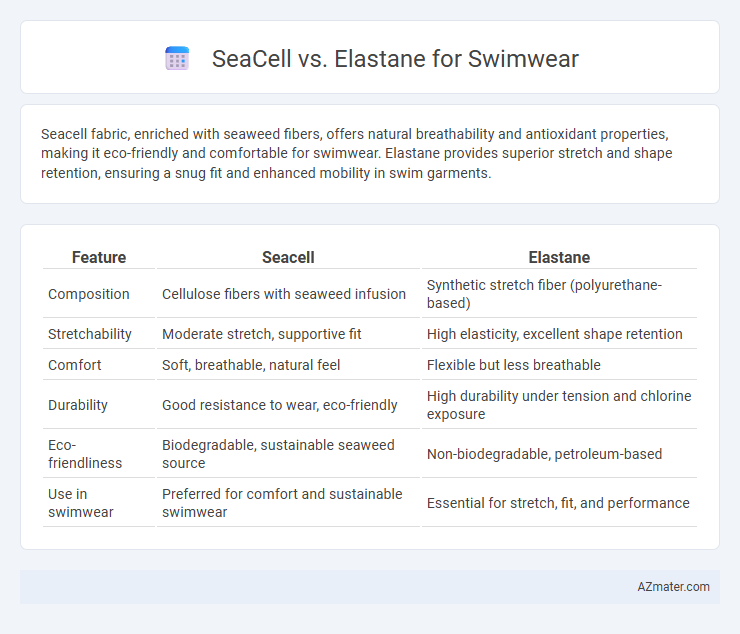Seacell fabric, enriched with seaweed fibers, offers natural breathability and antioxidant properties, making it eco-friendly and comfortable for swimwear. Elastane provides superior stretch and shape retention, ensuring a snug fit and enhanced mobility in swim garments.
Table of Comparison
| Feature | Seacell | Elastane |
|---|---|---|
| Composition | Cellulose fibers with seaweed infusion | Synthetic stretch fiber (polyurethane-based) |
| Stretchability | Moderate stretch, supportive fit | High elasticity, excellent shape retention |
| Comfort | Soft, breathable, natural feel | Flexible but less breathable |
| Durability | Good resistance to wear, eco-friendly | High durability under tension and chlorine exposure |
| Eco-friendliness | Biodegradable, sustainable seaweed source | Non-biodegradable, petroleum-based |
| Use in swimwear | Preferred for comfort and sustainable swimwear | Essential for stretch, fit, and performance |
Introduction: Seacell and Elastane in Swimwear
Seacell, a fiber derived from seaweed, offers natural breathability and skin-nourishing properties ideal for swimwear. Elastane, known for its exceptional stretch and shape retention, provides swimwear with flexibility and durability. Combining Seacell's eco-friendly benefits with Elastane's elasticity creates swimwear that balances comfort, performance, and sustainability.
What Is Seacell?
Seacell is a biodegradable fiber made from a blend of cellulose and seaweed, offering natural moisture-wicking and antibacterial properties ideal for swimwear. This innovative fabric delivers enhanced comfort, breathability, and UV protection while being environmentally friendly. Unlike elastane, which provides excellent stretch and shape retention, Seacell focuses on sustainable performance and skin-friendly benefits.
What Is Elastane?
Elastane, also known as spandex or Lycra, is a synthetic fiber renowned for its exceptional elasticity, making it a popular choice in swimwear for ensuring a snug and flexible fit. It can stretch up to five times its original length and quickly recovers its shape, providing durability and comfort in wet and active environments. Elastane blends seamlessly with other fibers like nylon or polyester, enhancing the fabric's strength, resistance to chlorine, and freedom of movement essential for swimwear performance.
Key Properties of Seacell Fabric
Seacell fabric, enriched with seaweed fibers, offers exceptional moisture-wicking and antibacterial properties, making it ideal for swimwear that requires hygiene and comfort. Its natural minerals promote skin regeneration and provide UV protection, enhancing the swimwear's functional benefits beyond elasticity. Unlike elastane, which primarily provides stretch and shape retention, Seacell adds bioactive skincare advantages and superior breathability to swimwear garments.
Key Properties of Elastane Fabric
Elastane fabric, commonly known as spandex or Lycra, is highly valued in swimwear for its exceptional elasticity, allowing garments to stretch up to five times their original size without losing shape. This material provides superior freedom of movement and a snug, comfortable fit, essential for active swim conditions. Its quick-drying properties and resistance to chlorine and UV exposure enhance durability, making elastane an optimal choice for performance swimwear compared to Seacell.
Comfort and Fit: Seacell vs. Elastane
Seacell fabric offers superior breathability and moisture-wicking properties, making swimwear exceptionally comfortable in warm conditions by keeping the skin dry and cool. Elastane provides remarkable stretch and shape retention, ensuring a snug fit that moves seamlessly with the body during swimming activities. Combining these materials can result in swimwear that balances natural comfort and flexibility with optimal fit and support.
Durability and Performance Comparison
Seacell swimwear offers excellent moisture-wicking and antibacterial properties, maintaining fabric freshness during extended use, while elastane provides superior elasticity and shape retention, crucial for active swimming. Elastane's high durability under repeated stretching makes it resilient to wear and deformation, whereas Seacell, being a cellulose fiber blended often with nylon or polyester, may have moderate durability but excels in comfort and skin benefits. For performance, elastane blends enable enhanced flexibility and chlorine resistance, making them ideal for competitive swimwear, whereas Seacell suits prioritize eco-friendly attributes combined with moderate performance for casual or leisure swimming.
Sustainability: Eco-Friendliness of Seacell and Elastane
Seacell swimwear fabric offers exceptional eco-friendliness by incorporating sustainably harvested seaweed, which promotes biodegradability and reduces environmental impact during production. Elastane, while providing superior stretch and comfort, is derived from synthetic polymers that contribute to microplastic pollution and have a higher carbon footprint due to fossil fuel-based manufacturing processes. Choosing Seacell over Elastane supports sustainability efforts by utilizing renewable resources and minimizing harmful waste in the textile industry.
Skin Benefits and Hypoallergenic Qualities
Seacell fabric, enriched with seaweed fibers, offers natural skin-soothing properties and promotes hydration, making it ideal for swimwear with enhanced skin benefits. Elastane provides excellent stretch and shape retention but lacks inherent hypoallergenic qualities, potentially causing irritation for sensitive skin. Swimwear combining Seacell's anti-inflammatory and detoxifying effects with Elastane's flexibility delivers comfort, skin protection, and durability.
Seacell vs. Elastane: Which is Best for Swimwear?
Seacell offers natural breathability, moisture-wicking, and sustainable benefits, making it ideal for eco-conscious swimwear shoppers seeking comfort and skin-friendly materials. Elastane provides superior stretch and shape retention, ensuring a snug, flexible fit crucial for active swimwear performance. Choosing between Seacell and Elastane depends on prioritizing either natural fabric benefits or high elasticity essential for swimwear durability and movement.

Infographic: Seacell vs Elastane for Swimwear
 azmater.com
azmater.com